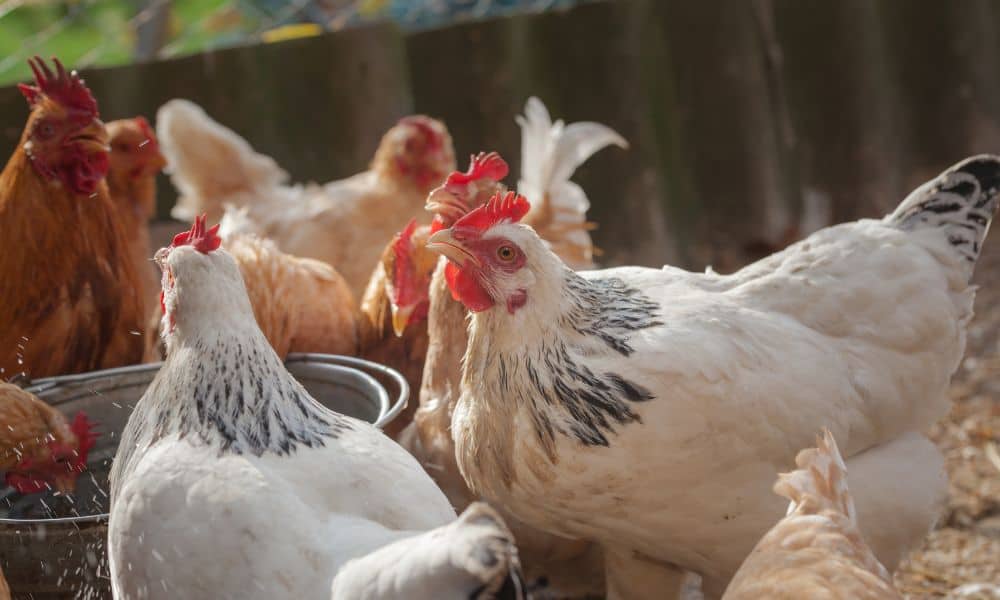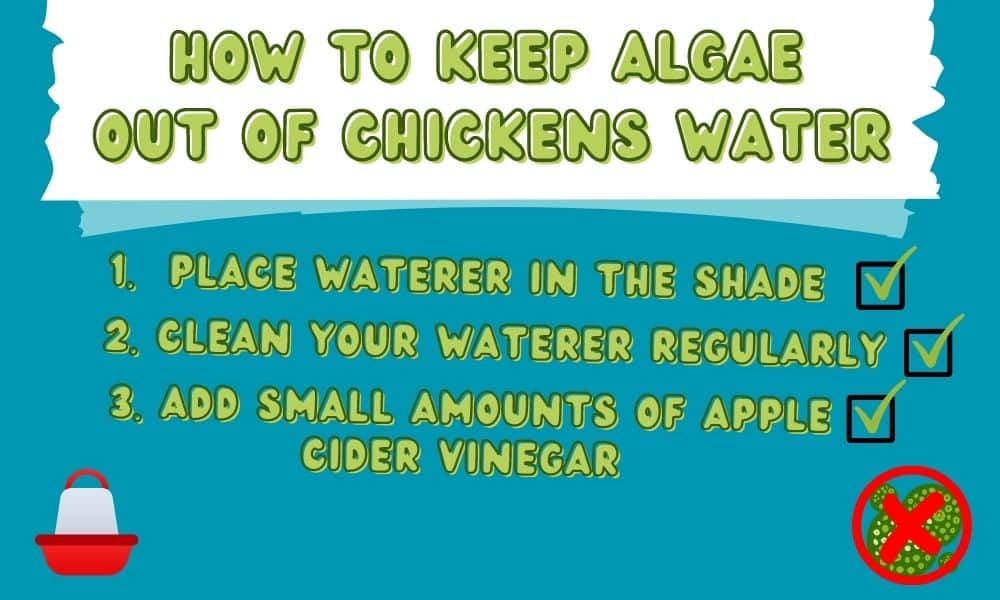Believe me, I get it.
It’s near impossible to keep your chicken waterer clean 100% of the time.
Though, If you’ve ever seen a green tinge in your chicken’s water, it’s an immediate sign that it needs a good clean!
This green tinge is actually algae, but don’t worry, you’re not destined to put up with it your entire chicken-raising journey, no, no.
Here’s everything you need to know about this green annoyance and how to keep algae out of your chicken waterer for good.
Contents
The Importance Of Clean Water For Chickens

If you wouldn’t drink the chicken’s water, why should they?
Keeping your chicken’s water clean and clear of debris will eliminate any nasty water-borne bacteria and diseases.
Plus, the cleaner and nicer the water is, the more often your chickens will WANT to drink water. Really, this goes a long way. The lack of access to water for even just a few hours is enough to start impacting their egg production.
A hydrated chicken is a happy chicken, right?
Chicken Waterer Turning Green? – Understanding Algae
Sometimes it’s dumfounding. You’ve cleaned your chickens waterer recently but after just a few days you can see the water’s developing that distinctly green tinge in it again.
Yup, that’s algae.
Algae is a broad group of aquatic plants. But, just like most plants, they need to perform photosynthesis to grow, thriving in environments with both carbon dioxide and light.
And therein lies the key. Take away exposure to sunlight or direct light and algae suddenly struggles to grow.
How To Keep Algae Out Of Chicken Waterers For Good!

A cure for algae is cleaning your chicken’s waterer. But, the best way to keep algae out of your chicken waterer for good is to focus on prevention.
Here are the most reliable ways to keep algae out of your chicken waterers for good:
Location Of The Waterer
The very wondrous way that plants grow, through photosynthesis, can also be their downfall.
By simply removing direct light from the equation, many plants including algae struggle to grow.
So, the number one most important thing you can do to prevent algae from growing in your chicken waterer is to place your waterer in a spot that remains in the shade throughout the whole day!
Regular Cleaning
The green algae that grow in chicken waterers almost always come from the wind, with the small algal cells being able to move through the air.
So, it’s quite inevitable that your chicken waterer will at some point end up with algae.
That’s why it’s always worth properly and thoroughly cleaning your chicken waterer every week, giving it a proper scrub in case any budding algae or other nasties are growing on the bottom.
Apple Cider Vinegar
Aside from the clear benefits that apple cider vinegar brings to your chicken’s health and well-being, apple cider vinegar is a great way to prevent algae growth in your waterer.
That’s because apple cider vinegar turns the water slightly acidic, making it much less conducive to algae growth.
Using a mere tablespoon per gallon of water is enough to stave off algae growth, AND for your chickens to experience its benefits.
Yup, it’s clear that algae don’t like apples, cider, or vinegar!
Interestingly enough, apple cider vinegar isn’t the only solution you can add to your chicken’s water, some actually add small amounts of different fruit juice, different diluted teas, or even Gatorade for electrolytes!
Types Of Algae In Your Chicken Waterers
Not sure if it’s actually algae or something else growing in your waterer?
Here are the two most common types of algae you’ll find, how they appear in chicken waterers, and what you can do to boot them out.
Green Algae
The most common perpetrator in chicken waterer inventions: green algae.
Most of the time you’ll notice green algae by its bright green color and its thick build-up at the bottom of your chicken waterer – it really requires a bit of scrubbing to get 100% off!
Green algae grow easily, quickly multiplying in warm, sunny conditions. Best to get rid of it by giving your chicken waterer a thorough wash and scrub, and keeping it in a spot that’s permanently shady!
Brown Algae
Brown algae isn’t as common as green algae, but it’s certainly just as annoying!
Given it’s less brightly colored it can sometimes be harder to spot. Instead of giving the water a brown appearance, it simply makes it appear a bit dirty.
Luckily, brown algae are easier to clean off and grow with less ferocity than green algae.
How To Properly Clean Chicken Waterer To Prevent Algae
If it seems that no matter what you do algae keeps growing in your chickens waterer, you might need to adjust how you’re cleaning your waterer.
You see, algae can be quite persistent and it attaches itself pretty well to most materials.
Here’s how to give your chicken waterer a deep clean, one that will certainly rid of any persistent algae:
- Rinse: Empty and rinse the inside and outside of your waterer.
- Wash: with hot soapy water, lather up every part of your chicken waterer, getting in all the nooks and crannies.
- Scrub: with hot soapy water, get a brush or coarse sponge and scrub the entire surface of the waterer, inside and out.
- Repeat: Once you’ve adequately scrubbed and washed the waterer, it’s time to rinse it, and repeat the above process once more quickly, just to be thorough!
Does The Type Of Chicken Waterer Matter?
You can quite effectively combat algae growth in any chicken waterer by simply keeping it in the shade, cleaning it regularly, and adding a small amount of apple cider vinegar too.
In saying that, there are some chicken waterers that also come with “additional protection” against algae growth.
These being:
- Those that have smaller openings allow less air to come in contact with the water.
- Those that are made of non-transparent material, reflecting a lot of light that would otherwise stimulate photosynthesis of the algae
- Those that are naturally easy to clean.
Is It Safe For Chickens To Drink Water If There’s Algae In It?
If you’ve noticed a little bit of green algae build up in your waterer and you’re worried about your chicken’s safety, don’t worry.
Assuming the algae is only in normal, smaller quantities, the water will be perfectly OK for your chickens to drink.
It’s only in high quantities that algae can become toxic, or at least be considered unhealthy for your chickens.
Still, it’s always good practice to clean your chicken waterer regularly, especially if you notice any algae or grime build-up.
Quick Recap
Although it’s almost inevitable that you’ll face the algae challenge sometime during your chicken-raising journey, the fix isn’t cumbersome.
Proactive prevention is always the best tactic to tackle algae in your chicken’s water.
The cheat code? Keep your waterer in the shade, add a tablespoon of apple cider vinegar per gallon of water, and clean your waterer on a weekly basis.
Have any other tactics to fight algae growth? Let us know in the comments below!
